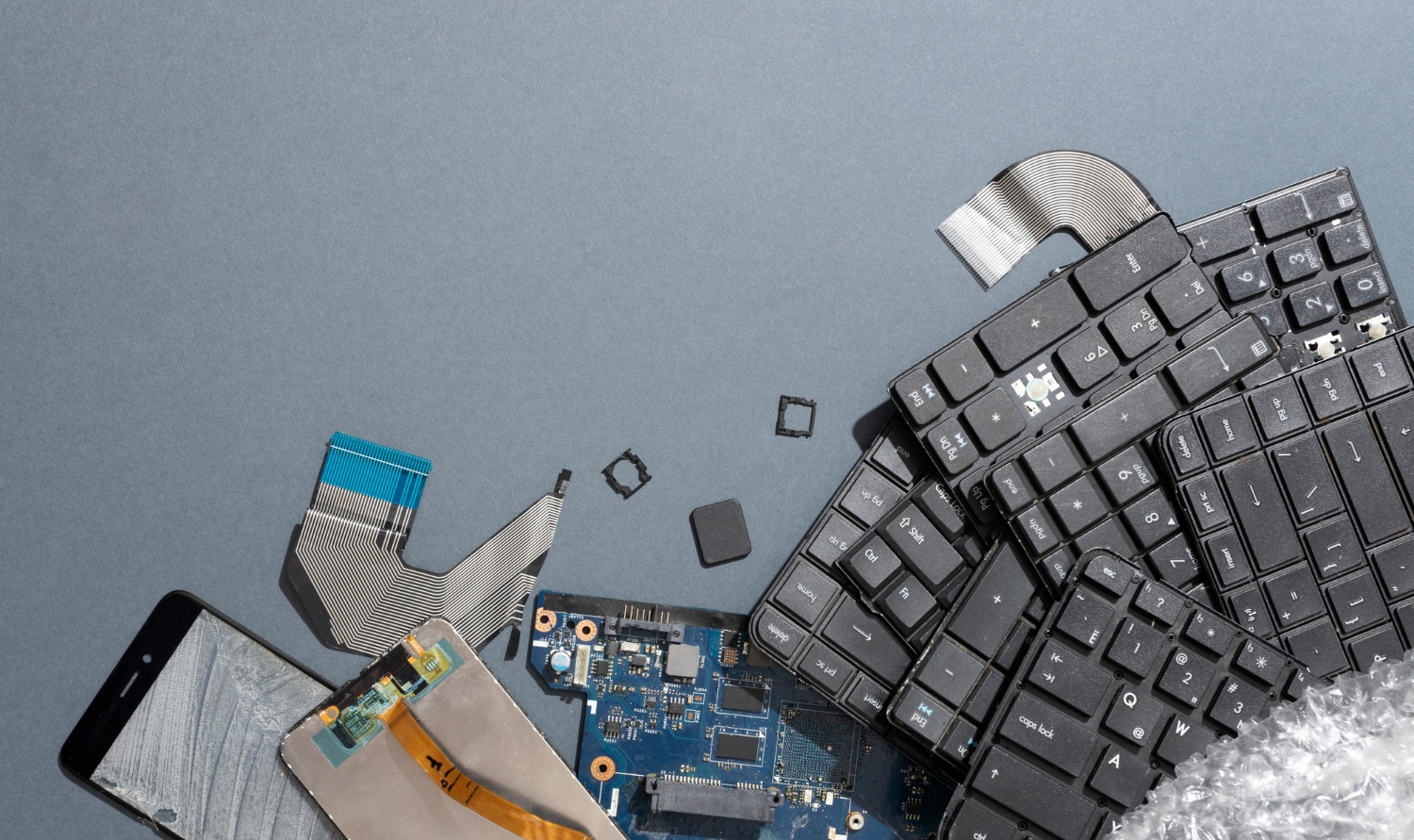
Properly managing IT assets is critical for modern companies, especially as data security concerns grow and technology lifespans shorten. IT asset disposition (ITAD) refers to the systematic process of securely, sustainably, and legally retiring IT assets, ensuring compliance with regulations and minimizing environmental impact.
This post will explain ITAD, its advantages, the challenges companies face, and how innovative tools, like itemit IT Inventory Software, streamline ITAD procedures for businesses of all sizes. Whether you’re refining your ITAD strategies or starting from scratch, this guide equips you to manage IT assets confidently.
Defining IT Asset Disposition (ITAD)
Understanding the role of IT asset disposition in managing the lifecycle of technology assets is essential. ITAD encompasses the responsible, safe, and sustainable disposal of outdated or underutilized IT assets. A well-structured inventory system forms the foundation of an effective ITAD strategy for small businesses. Below is a detailed guide to creating one tailored to your needs:
Step 1: Identify and Categorize Your IT Assets
Begin by listing all IT assets your business owns, such as laptops, servers, phones, and software licenses. Categorize these assets based on type, usage frequency, and condition. A clear inventory structure simplifies tracking and supports a professional approach to IT asset disposition.
Step 2: Select the Right Inventory Management Tool
Choose an inventory management tool that aligns with your business needs. Cloud-based asset-tracking solutions like itemit provide scalability, real time updates, and ease of use, making them ideal for small businesses. Features like barcode scanning and automated updates reduce manual work and improve accuracy.
Step 3: Assign Ownership and Track Usage
Assign each asset to a specific team member or department. This step fosters accountability and ensures precise tracking of asset usage and condition. Monitoring asset usage helps identify when assets approach the end of their lifecycle, enabling proactive IT asset disposition planning.
Step 4: Set Policies for Asset Lifecycle Management
Develop clear policies detailing how and when assets will be retired or disposed of. Include guidelines for secure data wiping, recycling, and resale. These policies reduce data security risks and ensure environmental compliance.
Step 5: Integrate ITAD Processes into Your Inventory System
Integrate your IT inventory system with IT asset disposition processes. For instance, flag assets nearing obsolescence and automate reminders for evaluation and action. This integration ensures no retired assets are overlooked.
Step 6: Regularly Audit and Update Your Inventory
Conduct regular audits to maintain an accurate inventory. Update entries to reflect new acquisitions and retired assets. Routine audits ensure IT asset disposition processes remain effective and informed.
By implementing a tailored inventory system, your business can efficiently manage IT assets while adopting responsible and compliant ITAD practices. Leveraging itemit’s features ensures a seamless transition from asset use to disposal.
Key Components of ITAD
To grasp IT asset disposition (ITAD) fully, it’s crucial to understand its foundational elements. Among these, an effective inventory management system stands out. Let’s explore what this system entails and its role in supporting ITAD for small businesses.
What Is an Inventory Management System?
An inventory management system helps businesses track, monitor, and organize IT assets throughout their lifecycle. For IT assets, this system ensures you know what devices you own, where they are, and their current condition. Integrating this system with ITAD technologies allows informed decisions about asset retirement, recycling, or resale, ensuring compliance with ITAD requirements.
Types of Inventory Management Systems
1. Manual Inventory Management Systems
Manual systems rely on spreadsheets, physical logs, or handwritten records to track IT assets
Pros:
- Low initial cost, making it accessible for small businesses.
- Minimal training required for basic use.
- No reliance on technology, reducing risks of technical failures.
Cons:
- Time-intensive and prone to human error.
- Difficult to scale as the business grows.
- Limited integration with ITAD workflows or advanced automation tools.
2. Automated Inventory Management Systems
Automated systems use software platforms or cloud-based solutions to manage assets in real-time. Features often include barcode scanning, RFID tagging, and ITAD integration.
Pros:
Saves time by automating updates and alerts.
Scales effortlessly as your inventory grows.
Enhances accuracy and reduces human errors.
Facilitates smooth end-of-lifecycle transitions by integrating with ITAD workflows.
Cons:
Higher upfront costs, which might deter some small businesses.
Requires training for optimal use.
Relies on consistent data input and maintenance.
Which System Is Right for Your Small Business?
The choice between manual and automated systems depends on your business size, budget, and IT asset complexity. A manual system may suffice for a startup with a limited number of assets, but as you scale, the benefits of automation outweigh the initial investment. Automation ensures seamless integration with what ITAD means in practice—responsible, secure, and efficient asset disposition.
Whether you choose manual or automated tools, a robust inventory management system is the backbone of effective ITAD. It allows small businesses to adopt professional standards in managing IT assets while staying agile in a competitive marketplace.

ITAD Technologies and Solutions
Technology plays a pivotal role in effective IT asset disposition. Businesses increasingly rely on advanced ITAD technologies to track, manage, and dispose of IT assets responsibly. Innovations like itemit are reshaping how companies approach ITAD and stay competitive in a rapidly evolving market.
Overview of ITAD Technologies
Asset Tracking Tools
ITAD solutions include advanced tracking systems like barcode scanning, RFID tagging, and GPS-enabled tracking. These tools provide real-time visibility into your IT asset inventory, ensuring efficient lifecycle management.
Cloud-Based ITAD Platforms
Cloud platforms offer centralized IT asset management, including automated alerts, compliance tracking, and secure data destruction logs. itemit’s cloud-based capabilities make asset disposition effortless and compliant.
Data Erasure and Security Software
Secure data destruction is critical. Specialized software ensures permanent data removal, meeting regulatory standards and protecting sensitive business information.
Analytics-Driven Solutions
Predictive analytics tools enable businesses to anticipate asset obsolescence, optimize usage, and plan upgrades or replacements. These insights drive proactive ITAD decisions.
What Is Digital ITAD?
Digital ITAD refers to technology-driven processes that modernize traditional ITAD workflows. By automating tasks and leveraging real-time tracking, digital ITAD simplifies asset lifecycle management while enhancing data security and compliance.
Benefits of Digital ITAD for Modern Organisations
Enhanced Efficiency: Automation reduces time spent on manual tasks.
Real-Time Insights: Dynamic tracking ensures accurate inventory records.
Stronger Data Security: Secure data erasure tools minimize risks.
Regulatory Compliance: Built-in compliance tracking meets environmental and data protection standards.
Cost Savings: Optimized asset utilisation reduces waste and costs.
Cloud-based Inventory Management Systems for Small Business
Small businesses are embracing cloud-based inventory systems to simplify ITAD processes. With flexibility, scalability, and real-time capabilities, these systems align perfectly with the demands of modern IT asset management.
Benefits of Digital ITAD for Modern Organisations
Operating entirely online, cloud-based systems allow users to access, update, and track inventory from anywhere.
These systems are particularly valuable in asset disposition management, enabling seamless integration with processes like IT asset tracking, retirement, and secure data erasure.
How Cloud-Based Systems Differ from Traditional Systems
Feature | Traditional Systems | Cloud-Based Systems |
Accessibility | Limited to on-site access | Accessible anywhere via the internet |
Scalability | Requires additional hardware for scaling | Scales easily with subscription upgrades |
Updates | Manual updates and upgrades | Automatic updates with no downtime |
Integration | Often lacks integration capabilities | Integrates with IT tools for secure IT asset disposition |
Benefits of Cloud-Based Inventory Management Systems
- Real-Time Asset Tracking
Cloud systems offer real-time updates on IT asset status, location, and usage. This is crucial for businesses managing the lifecycle of assets and planning IT asset disposition processes. - Cost-Effective Scalability
Small businesses can start with a basic package and scale up as their needs grow. There’s no need to invest in costly hardware or IT support for expansion. - Improved Security
Security is a top concern in the IT asset disposition industry. Cloud-based systems use encryption, multi-factor authentication, and secure data backups, ensuring safe handling of sensitive information during asset retirement. - Enhanced Collaboration
With centralized data accessible to authorized team members, cloud systems facilitate collaboration across departments. Teams can coordinate on asset use, maintenance, and disposal more efficiently. - Integration with Asset Disposition Tools
Cloud platforms often integrate directly with ITAD services, enabling businesses to automate parts of the asset disposition management process, such as scheduling device pick-ups, tracking recycling, or securely wiping data. - Regulatory Compliance Made Easy
Built-in compliance features help small businesses adhere to environmental and data protection regulations, critical for secure IT asset disposition. These systems automatically generate audit trails and compliance reports, saving time and reducing risks.
Empowering Small Businesses with Cloud Solutions
Cloud-based inventory management tools provide small organisations with a revolutionary chance to properly and ethically manage IT assets. Companies can adopt more dynamic, secure, scalable solutions that fit perfectly with the needs of the contemporary IT asset disposal sector by switching from conventional systems.
Benefits of IT Asset Disposition

Managing IT assets effectively is essential for any business that relies on technology. When done right, IT asset disposition (ITAD) offers several key benefits that go beyond simply retiring old equipment. It helps organisations save money, stay secure, and operate more sustainably. Let’s break it down.
1. Cost Efficiency Through Effective Lifecycle Manageme
One of the most significant advantages of IT asset disposition is cost savings achieved by optimizing asset usage throughout its lifecycle. ITAD practices enable businesses to track, maintain, and evaluate assets to ensure maximum utilization before their retirement.
How ITAD Saves Costs:
- Resale and Recycling Revenue: ITAD facilitates the resale or recycling of retired assets, turning unused equipment into financial gain.
- Avoiding Overstock: Integrating ITAD with automated inventory management benefits ensures businesses don’t over-purchase or underutilize equipment.
- Reduced Storage Costs: Retiring obsolete assets frees up physical and digital storage, lowering associated costs.
For small and medium-sized enterprises (SMEs), these savings can be a game-changer, allowing them to reallocate resources toward growth initiatives.
2. Mitigation of Data Breach Risks
Retiring IT assets raises major questions about data breaches. Legal, financial, and reputation hazards can all be exposed to companies by improper disposal or neglect to delete sensitive data from devices.
Secure IT Asset Disposition Reduces Risk:
- Comprehensive Data Erasure: ITAD suppliers guarantee that sensitive data is permanently deleted by means of certified data-wiping technology.
- Tracking and Reporting: Audit trails and certifications of destruction are among ITAD procedures, therefore providing compliance assurance and peace of mind for companies.
- Automated Risk Alerts: Using the benefits of automated inventory control, companies may find assets approaching end-of-life and make plans for safe disposal before they start to become a liability.
Maintaining confidence and compliance in the strict GDPR and CCPA-oriented IT asset disposal market of today depends on safe ITAD procedures.
3. Environmental Sustainability and Corporate Responsibility
ITAD helps companies as well as supports environmental sustainability. Companies less their environmental impact by recycling products and properly disposed of e-waste. To guarantee environmental compliance, several ITAD suppliers work with accredited recyclers.
Key Sustainability Benefits:
- Minimizing e-waste in landfills.
- Recovering valuable materials like gold and copper from electronics.
- Enhancing corporate reputation by aligning with green initiatives.
4. Streamlined Operations with Automation
Automating ITAD processes through advanced technologies like cloud platforms and AI tools simplifies asset disposition management. Benefits for proper management include real-time tracking, predictive maintenance alerts, and automated scheduling for asset pickup or recycling.
Why Automation Matters:
- Speeds up ITAD workflows, reducing downtime.
- Eliminates human error in tracking and reporting.
- Provides actionable insights for better asset lifecycle planning.
ITAD: A Strategic Necessity for Modern Businesses
Adopting ITAD techniques is now a strategic need rather than a choice in the competitive IT asset disposal market. Beyond just financial savings, ITAD provides strong defense against data breaches and supports environmental sustainability. Automation and cloud technologies help companies to manage their IT assets with more security and efficiency.
IT Asset Disposition Market Overview
The IT asset disposition (ITAD) market is growing faster than ever as businesses seek reliable ways to manage retired devices. With data security becoming a top concern and sustainability goals gaining traction, ITAD solutions have evolved from being a niche service to a critical part of IT management.
What’s Driving ITAD Growth?
- Data Protection as a Priority
Companies manage more sensitive data than ever, hence safe disposal of outdated equipment is increasingly non-negotiable. Companies are looking to accredited ITAD companies who promise data erasure and have proof to support it. These steps guarantee privacy law compliance including GDPR and CCPA in addition to preventing breaches. - Sustainability and Recycling Efforts
One significant issue is e-waste. Businesses want to help by properly recycling used IT equipment and repurposing workable components. This reduces landfill contributions while yet complementing business sustainability objectives. - The Shift Toward Automation
Companies automating ITAD processes save time and reduce mistakes. Predictive analytics, cloud-based solutions, and real-time tracking help one better manage big inventories and schedule device replacements or updates. - Global Reach and Emerging Markets
The demand for ITAD services grows along with corporate size. Emerging countries are using ITAD solutions more and more, giving suppliers fresh chances to satisfy rising needs all around.
Who’s Leading the Market?
Several companies are at the forefront of the IT asset disposition market, offering cutting-edge technologies and secure solutions:
- Sims Lifecycle Services (SLS): A global provider specializing in recycling and data destruction services.
- Iron Mountain: Known for its secure handling of sensitive assets, with strong focus on data protection.
- Arrow Electronics: Offers tailored solutions for businesses at all scales, focusing on lifecycle optimization.
- TES-AMM: Pioneers in green ITAD practices, ensuring compliance with environmental regulations.
Technologies Changing the Game
- Blockchain Transparency
Blockchain is being used to track IT assets from acquisition to retirement, ensuring nothing slips through the cracks. - AI-Powered Insights
Predictive analytics tools help businesses plan for IT upgrades, track asset depreciation, and decide when to retire devices. - Cloud Integration
Cloud-based ITAD systems simplify everything, letting companies manage assets remotely and stay updated in real time. - Advanced Data Destruction
Secure erasure methods—like degaussing and physical shredding—help businesses safeguard their data while disposing of equipment responsibly.
Challenges in ITAD Implementation
Implementing an effective enterprise IT asset disposition (ITAD) strategy can be complex. While ITAD technologies have advanced significantly, businesses often face challenges that can derail even the most well-planned processes. Understanding these obstacles and knowing how to address them is critical for success.
Common Challenges in ITAD Implementation
- Data Security Risks
Making sure sensitive data is totally deleted from defunct equipment is a main focus in ITAD. Inaccurate data deletion or dependence on unreliable techniques can expose companies to data breaches, therefore compromising their finances and reputation. - Regulatory Compliance
When disposing of IT equipment, companies must follow rigorous environmental rules and data security legislation. Without the appropriate ITAD tools or knowledge, negotiating the complex compliance terrain—particularly across several countries—can be taxing. - Poor Inventory Management
Disorganized asset tracking can lead to overlooked devices, incomplete records, or lost equipment, which complicates ITAD workflows. This is particularly problematic for enterprises managing large inventories of IT assets across various departments and locations. - Cost Management
While ITAD can create value through resale or recycling, it also incurs costs for secure data destruction, transportation, and compliance reporting. Without a clear strategy, businesses may struggle to balance these costs effectively. - Lack of Reliable Partners
Choosing an unreliable ITAD service provider can result in inadequate data security, improper disposal, or non-compliance with environmental standards. This not only jeopardizes business operations but can also trigger legal issues or penalties.
The Importance of Reliable ITAD Providers
Selecting the right ITAD partner is one of the most critical decisions in implementing a successful strategy. A trusted provider ensures your enterprise gets the support it needs to navigate challenges and maximize the value of asset disposition.
- Comprehensive Services: Reliable providers offer end-to-end solutions, from secure data erasure to certified recycling and remarketing.
- Compliance Expertise: They stay up to date with regulations, ensuring your ITAD process meets local and international standards, including documentation for a financial audit if required.
- Proven Track Record: Established providers bring years of experience and use advanced ITAD technologies to streamline workflows and mitigate risks.
Simplify ITAD with itemit IT Inventory Software
Managing the lifecycle of IT assets doesn’t have to be complicated. With itemit IT Inventory Software, businesses can streamline their asset management and IT asset disposition (ITAD) processes with ease. Designed to support modern ITAD practices, itemit combines advanced features like real-time tracking, automated workflows, and secure data management to make asset handling more efficient and effective.
Real-Time Tracking for Better Control
itemit’s real-time tracking feature allows you to monitor your IT assets at every stage of their lifecycle. Whether it’s tracking a laptop in active use or flagging a device nearing retirement, this functionality ensures nothing slips through the cracks.
- Stay Updated: Access asset information instantly from anywhere, reducing the risk of lost or unaccounted-for equipment.
- Enhanced Visibility: Gain a comprehensive overview of your inventory, which is critical for efficient dynamic ITAD implementation
Automated Workflows to Save Time
Say goodbye to manual tracking and outdated spreadsheets. itemit’s automated workflows simplify complex processes like asset tagging, usage monitoring, and retirement scheduling.
- Streamline ITAD Tasks: Automate alerts for devices approaching end-of-life, helping you plan ahead for secure disposition.
- Seamless Integration: Integrate itemit with other ITAD technologies for a unified asset management experience.
Automation not only saves time but also reduces errors, making your ITAD strategy more reliable and consistent.
Secure Data Management for Peace of Mind
Data security is at the heart of effective ITAD, and itemit has you covered. The software ensures sensitive information is managed securely, whether assets are in use or being prepared for disposal.
- Data Protection: Track and document data erasure processes for retiring devices.
- Compliance Ready: Generate detailed audit trails to ensure your ITAD processes meet regulatory requirements.
This focus on security aligns perfectly with the principles of digital ITAD, where technology is used to enhance data protection and ensure compliance
Compatible with Dynamic ITAD Solutions
itemit’s flexibility makes it a perfect fit for businesses adopting dynamic ITAD strategies. The software supports scalable, real-time processes that evolve with your organisation’s needs. Whether you’re managing a small fleet of devices or a global network of assets, itemit adapts to deliver tailored solutions.
Why Choose itemit for ITAD?
With itemit, IT asset management becomes intuitive and efficient. The software not only simplifies day-to-day operations but also ensures your ITAD processes align with modern best practices. By integrating features like real-time tracking, automation, and secure data management, itemit empowers businesses to:
- Save time and reduce costs.
- Protect sensitive data and maintain compliance.
- Adopt sustainable and scalable ITAD practices.
For businesses looking to optimize their IT asset lifecycle, itemit is the ideal partner. It combines the latest ITAD technologies with user-friendly tools, helping you manage assets smarter and more sustainably.

Try itemit
Choose a better way to track
your assets.
Start your free 14-day trial now!

Keep Learning
itemit Blog
Tips, guides, industry best practices, and news.
Inventory Planning Best Practices: Avoid Stockouts and Overages with Asset Tracking
Discover inventory planning best practices to avoid stockouts and overages. Learn how asset tracking improves accuracy, reduces waste, and optimizes supply chain management.
How to Optimise Product Inventory Management
Learn how to optimize product inventory management with effective strategies, a product inventory management system, and best practices for efficiency.
How to Keep Your Asset Record Accurate and Up-to-Date
An accurate asset record is crucial for businesses aiming to optimise their operations, minimise costs, and enhance compliance. With itemit’s intuitive fixed asset management software, you can streamline your asset tracking process, ensuring that your records are always current and reliable.


